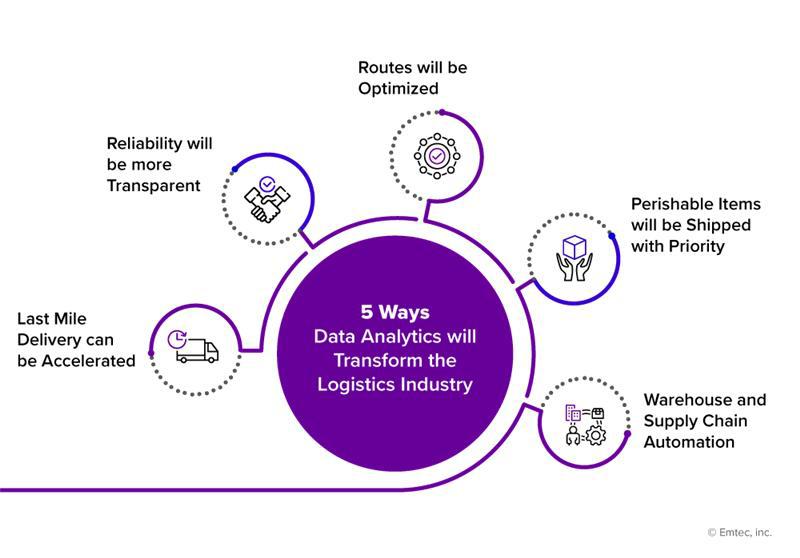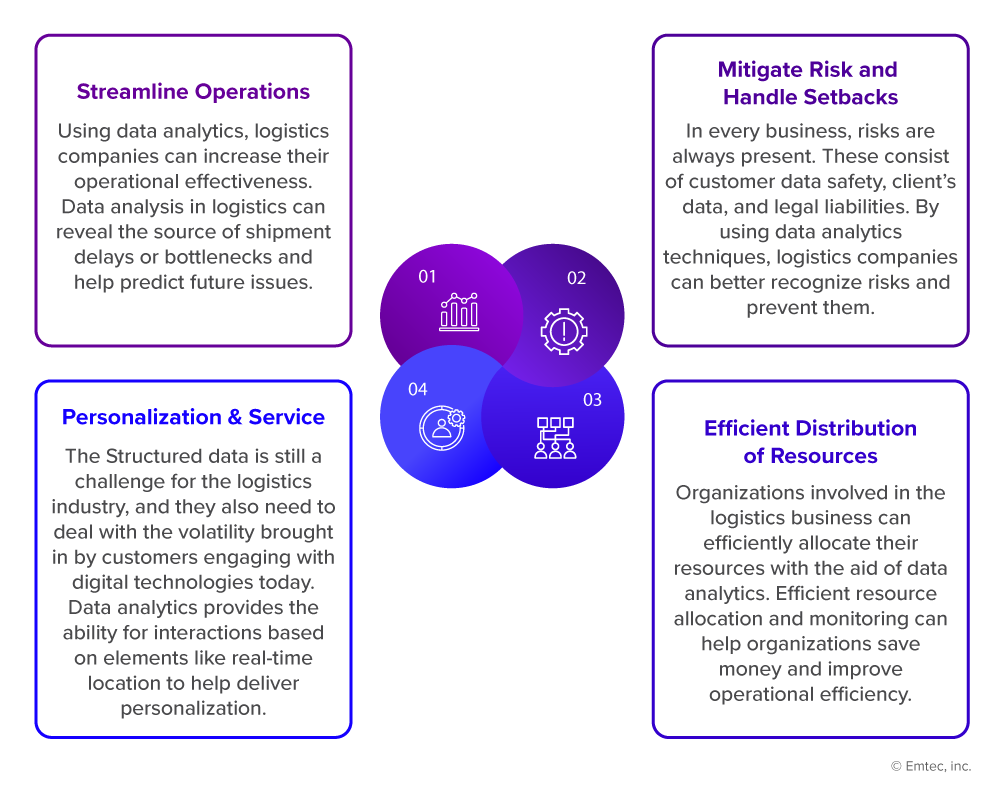Data analytics can help you derive phenomenal benefits. With strengthened supply chains and streamlined operations translating to cost savings and increased profitability, data analytics is a promising tool for optimizing logistics functions. Read on to explore the rising trend!
The Rise of Data Analytics in Logistics
Without any doubt, data analytics has become one of the most important technological tools for the logistics industry. With data analytics, organizations can monitor their supply chains, spot problems in real-time, and adjust swiftly.
These keen insights enable logistics companies to learn and evolve to adapt quickly and effectively, preventing costly delays and interruptions in the supply chain while substantially improving both their operations and ROI.
This shift towards data-driven decision making is now possible thanks to the plethora of tools now available for analyzing data, helping drive the cost of processing data down.
Traditionally, supply chain managers performed data analysis manually or with limited digital tools. Now, modern data analytics tools empower teams with the insights they need to better estimate demand, optimize inventory planning, and decipher hidden patterns and trends in massive data sets.
This technology continues to push boundaries and drive innovation across the global logistics landscape.
79% of CSCOs are developing training to drive adoption of advanced analytics – Gartner
5 Ways Data Analytics will Transform the Logistics Industry

- Last-Mile Delivery will be Accelerated
The traditional last mile delivery process costs up to 28% of the overall delivery cost of a package. The ‘last mile’ problem also encompasses the difficulties associated with the transportation of goods to urban regions, where the hustle and bustle can cause congestion and safety hazards. In addition to these obstacles, it can be difficult to determine precisely what is happening during the final leg of delivery. Data analytics aims to address these challenges.
- Reliability will be more Transparent
As sensors grow increasingly widespread in transportation vehicles, shipping, and the supply chain, they can provide data that enables greater transparency than ever before. This transparency is beneficial to shippers, carriers, and customers since they may use the aggregate data to negotiate with shippers by demonstrating how frequently they make on-time deliveries.
- Routes will be Optimized
Big data and predictive analytics provide logistics companies with the competitive edge they need to overcome obstacles by using weather data, road maintenance data, fleet maintenance schedules, real-time fleet status indicators, and personnel schedules. All these data types can be integrated into a system that analyses historical trends and provides advice accordingly.
- Perishable Items will be Shipped with Priority
Maintaining the freshness of perishable goods has been an ongoing concern for logistics organizations. Nevertheless, data analytics and the Internet of Things could provide delivery drivers and managers with a much better understanding of how to reduce expenses associated with perishable commodities. The sensors give data such as traffic and roadwork information to inform vehicles of optimal delivery routes.
- Warehouse and Supply Chain Automation
Soon, data analytics paired with automation technology and the Internet of Things may completely automate the logistics industry. Data analytics enables automated systems to operate by effectively routing several data types and data streams.
The Challenges of Implementing Data Analytics in Logistics
In comparison to other businesses, the logistics industry does not lack data. The industry generates and utilizes some of the largest volumes of data assets across all industries. The challenges of harnessing this data for analytics lies elsewhere:
- Dispersed Data
Logistics data is dispersed across numerous silos and systems. From CRM and ERP data, sales orders, and financial reports to distributor pricing lists, warehouse reports, and more, there is no unified repository for data storage at a centralized location.
- Variable Data Quality
Sometimes, data is nicely structured in a relational database, and sometimes is isn’t. Varying data quality across the supply chain requires additional hours of labor to differentiate, validate, and clean prior to analysis.
- Lack of Integrated Analytics
Companies in the logistics industry provide reports as ad hoc, one-time analyses. Instead, they should design integrated systems that speed the process of data collection, cleaning, and analysis to supply a constant stream of information for real time performance tracking.
- No Business Function based Analytics
Reporting on analytics may not effectively break downs into specific business functions or processes. For instance, your organization can determine whether they have generated a profit or loss but cannot determine which business units did better or worse. The challenge is to develop a data model that enables business-specific breakdowns.
Techniques of Data Analytics Implementation in Logistics
Data (in both structured and unstructured formats) flows through many channels, such as real-time vehicle sensors for temperature and speed, external sources like vehicle maintenance information, fuel logs, and DOT records, and internal data stores from HR, SCM, and CRM systems.
Third-party logistics providers can also receive billions of data points from sensors, telematics data, video systems, and back-office platforms. These public records are a goldmine for data scientists. The scientists can use predictive and prescriptive analytics to data sets to forecast and alter to avoid future issues.
- Predictive Analytics
The development of big data analytics and machine learning has ushered in the age of predictive analytics. Predictive analytics takes data like order ledgers, supply links, price changes, etc. into consideration and uses that data to forecast future trends.
- Prescriptive Analytics
Prescriptive analytics takes predictive analytics one step further by examining what has worked (or not) in the past and then recommending a course of action to change future outcomes. The primary distinction between the two is that predictive analytics answers the question, “What will happen?” “In contrast, prescriptive analytics empowers you to alter future events.
Features of Data Analytics in Logistics Industry
Now that we understand how data analytics can help logistics focused organizations, let’s review the prominent features of data analytics:

Bolstering Logistics Data Analytics with Data Lakes
Data lakes, sometimes called “data reservoirs,” can hold any amount of data, regardless of type or how it is stored. With machine learning (ML), big data processing, real-time analysis, and visualization dashboards, analytics, and insights, for more informed decisions can be achieved from this central repository.
So, what are the prerequisites for a productive data lake? Like with any endeavor, alignment with the business goals, executive sponsorship, and general support are key. Based on our experience with dozens of companies utilizing data lakes with varying degrees of success, these three conditions are crucial:

- The Right Platform
The most popular platforms for a data lake are big data technologies like Hadoop and cloud solutions like Microsoft Azure, Amazon Web Services (AWS), and Google Cloud Platform.
- The Right Data
Most of the logistical information collected today is either thrown away or saved in Excel spreadsheets. Most operational data, data made by machines, and historical data are either aggregated or thrown away, which makes conducting analytics difficult.
The data lake is essentially a piggy bank, where you save data without knowing why, but in case you need it in the future.
- The Right Interface
After implementing the right platform and importing the right data, we move on to the hardest part of a productive data lake, which is finding the right interface. This is where most businesses fail.
The Future of Logistics with Data Analytics
Data analytics plays a powerful role in helping logistics companies improve operations, minimize risk, and meet growing customer expectations. Logistics companies that have yet to implement data analytic solutions are at a significant disadvantage, particularly when faced with growing competition.
At Bridgenext, we understand the phenomenal advantage that logistics firms with data analytics capabilities carry. Bridgenext can help you to find actionable insights from your data sets.
Ensure your organization can effectively manage and visualize its logistics data. Connect with our experts at Bridgenext.
References
https://www.gartner.com/en/supply-chain/insights/supply-chain-analytics
www.supplychaindigital.com




